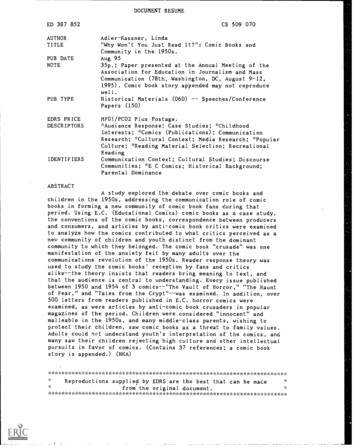
Transcription
DOCUMENT RESUMEED 387 852AUTHORTITLEPUB DATENOTECS 509 070Adler-Kassner, Linda"Why Won't You Just Read It?": Comic Books andCommunity in the 1950s.Aug 9535p.; Paper presented at the Annual Meeting of theAssociation for Education in Journalism and MassCommunication (78th, Washington, DC, August 9-12,1995). Comic book story appended may not reproducewell.PUB TYPEHistorical Materials (060)Papers (150)EDRS PRICEDESCRIPTORSMFOI/PCO2 Plus Postage.*Audience Response; Case Studies; *ChildhoodInterests; *Comics (Publications); CommunicationResearch; *Cultural Context; Media Research; *PopularCulture; *Reading Material Selection; RecreationalReadingCommunication Context; Cultural Studies; DiscourseCommunities; *E C Comics; Historical Background;Parental DominanceIDENTIFIERSSpeeches/ConferenceABSTRACTA study explored the debate over comic books andchildren in the 1950s, addressing the communication role of comicbooks in forming a new community of comic book fans during thatperiod. Using E.C. (Educational Comics) comic books as a case study,the conventions of the comic books, correspondence between producersand consumers, and articles by anti-comic book critics were examinedto analyze how the comics contributed to what critics perceived as anew community of children and youth distinct from the dominantcommunity to which they belonged. The comic book "crusade" was onemanifestation of the anxiety felt by many adults over thecommunications revolution of the 1950s. Reader response theory wasused to study the comic books' reception by fans and criticsalike--the theory insists that readers bring meaning to text, andthat the audience is central to understanding. Every issue publishedbetween 1950 and 1954 of 3 comics--"The Vault of Horror," "The Hauntof Fear," and "Tales from the Crypt"--was examined. In addition, over500 letters from readers published in E.C. horror comics wereexamined, as were articles by anti-comic book crusaders in popularmagazines of the period. Children were considered "innocent" andmalleable in the 1950s, and many middle-class parents, wishing toprotect their children, saw comic books as a threat to family values.Adults could not understand youth's interpretation of the comics, andmany saw their children rejecting high culture and other intellectualpursuits in favor of comics. (Contains 37 references; a comic bookstory is appended.) **************************Reproductions supplied by EDRS are the best that can be madefrom the original **************************
Linda Adler-KassnerComic Books and Community 1"Why Won't You Just Read It?": Comic Books and Community in the 1950sIntroductiontncot,coCultural critic Robert Warshow devoted his June, 1954 Commentarycolumn, "The Study of Man," to a rather unusual topic -- his son Paul'sdevotion to comic books published by E.C. comics. Warshow's discussion off.L.1his son's reading habits summarizes the hopes and fears of many 1950sparents, who feared that their Children had been "seduced" by comic books.Paul, I think, does not quite take [the Fan-Addict Club] with fullseriousness, but it is clear that he does in some way value hismembership in it, at least for the present . He has recruited a few ofhis schoolmates into the organization. If left free to do so, he will buyany comic book which bears the E.C. trademark, and is usually quitesatisfied with the purchase. This is not a matter of "loyalty," but seemsto reflect some real standard of discrimination; he has occasionallysampled other comic books which imitate the E.C. group and findsthem inferior. . . I know that I don't like the comics myself and that it makesme uncomfortable to see Paul reading them . . .I said once that the gross and continual violence of the comicbooks was objectionable.He said: "What's so terrible about things being exciting?"Well, nothing really; but there are books that are much moreexciting, and the comics keep you from reading thebooks .Why read the comics at all? . Oh, the comics are just stupid,that's all, and I don't see why you should be wasting so much timewith them.Maybe they're stupid sometimes. But look at this one. This oneis really good. Just read it! Why won't you just read it?Usually I refuse to "just read it," but that puts me at once at adisadvantage. How can I condemn something without knowing whatit is? . . (596).Warshow's article summarizes the unspoken apprehensions of thecomic book critics of the early 1950s. His inability to "just read it," his\,Aconcession that he does not glean the same meaning from the comic books asPaul does, demonstrates his belief that Paul and other comic book readers'PERMISSION TO REPRODUCE THIS TO THE EDUCATIONAL RESOURCESMATERIAL HAS BEEN GRANTED BY INFORMATION CENTER (FRICU S DEPARTMENT Of EDUCATIONDew e ot E dutationai Research and ImprovementPpnts ot v.ee, 0, opnions staled in Ind docurnenl do not necessarily tepresent OficialOE Fil posd.on or policyEDUCATIONAL RI SOURCES INFORMATIONilduk4 --(taatab210ithisCE NTE R (ERIC)dOcument haS been rePreduCest asreceived from the person or organrzahonAver(orgmahng .1' Mnor changes have been made to improvereproduction (weld yBEST COPY AVAILABLE
Comic Books and Community 2belonged to a separate community who interpreted the meaning of the booksdifferently than adult critics. Indeed, the divergent reading of comic books byadult critics and young fans was at the heart of an active anti-comic crusadethat stretched from the 1930s through the mid-1950s, ending only with thecreation of the Comics Code and the "Seal of Approval" that still appears onthe covers of many mainstream comic books today.This paper is about the debate over comic books and children in thelate 1940s and 1950s. It addresses the role of one form of communication,comic books, in forming a new community, of comic book fans, during thatperiod. Using E.C. comic books as a case study, this paper examines theconventions of the books,, correspondence between producers and consumers,and articles by anti-comic book critics in order to examine how the bookscontributed to what those critics perceived as a new community of childrenand youth that was distinct from the dominant community to which theybelonged. Research questions include: what evidence exists that E.C. comicsworked to create a community of readers? What were the values espoused bythis community, and were they significantly different than the community ofcomic book critics? What evidence exists that these critics perceived thesevalues differently?The argument here is the battle over the comic books providesevidence to demonstrate that children and other comic book fans wereforming a new community of which their parents were not a part, and comicbooks were but one mediator of that community.Those who fought comicbooks, like Robert Warshow, said that they objected to the books contents.But the stories were not the matter over which they waged their campaign;instead, the battle was over meaning. Anti-comic book forces fought the' ways
Comic Books and Community 3in which the different segments in the anti-comic crusade, producers, youngfans, and critics, used and decoded the comic books.Literature ReviewThe battle over comic books provides, as a case study, an opportunityfor the application of alternative theoretical approaches to masscommunication history. This paper applies concepts of "community,""community boundaries," and related concepts from cultural studies andliterary theory to anti-comic book arguments, comic book content, andcommunication between publishers and readers to reveal how a newcommunity of readers was formed and was perceived as diverging sosignificantly from non-readers values that it appeared threatening andsubversive of post-war culture.The concept of community is central to this paper. The argument isthat within a society, defined as the totality of all the communities in aparticular place in a given historical moment, thE re are many communitiesthat may have different values. This idea comes from the work ofinternational studies scholar Benedict Anderson (1978), who studied nationsas what he called "imagined communities," groups formed when peopleimagine themselves sharing common interpretations of mass-communicatedsymbols. When people interpret and define symbols as they think others do,they imagine themselves part of a community that shares not onlyinterpretation, but meaning and values, as well. According to Anderson,such communities areimagined because even the members of the smallest . . . will neverknow most of their fellow-members, meet them, or even hear them,yet in the minds of each lives their communion. . . In fact, allcommunities larger than primordial villages of face-to-face context(and perhaps even these) are imagined. Communities are to be.
Comic Books and Community 4distinguished not by their falsity/genuineness, but by the style in whichthey are imagined (6-7).There is one community, however, whose values are dominant andreflect the hegemony of the mcment. The dominant community is but oneimagined community, circulating within a society comprised of manyimagined communities. The primary difference between it and others,however, is that it is dominantits ideas, meanings, and definitions oflanguage have been anointed with the label of "common sense" because theyrepresent the interests of hegemony during a given historical moment.The definition of hegemony used here comes from RaymondWilliams (rep. 1989) and Stuart Hall (1986). Williams, first, defineshegemony as the "common sense" practices of a society, the "central effective,and dominant system of meanings and values. . .which are organized andlived" (383). But no hegemony is permanent. Hall notes that it is a contextspecific, multi-dimensional process. It is "a very particular, historicallyspecific, and temporary 'moment' in the life of a society," and thus must be"actively constructed and positively maintained" (15). Anti-comic bookcrusaders, who vigorousty worked to censor their children's and other fans'reading of the comic books, participated in the hegemony of the 1950s andwere members of what will be called here the dominant community. Whilecomic book fans may also have participated in that hegemony at othermoments, during the times that they actively expressed their devotion to thecomic books and the comic book community they were members of anoppositional community whose values were determined by members of thedominant community to be subversive to their own. Studying therelationship between comic books and their reception illuminates thisconflict within the society of the 1950s and broadens the investigation from
Comic Books and Community 5analysis of an object's contents to an analysis of its reception and themeanings attributed to it. This debate also provides an opportunity toobserve the ways that different communities created different meanings forthe books based on their own beliefs and values.Mass communication scholars have long grappled with the role ofcommunication in forming communities. From John Dewey and hisChicago School colleagues (for example, Peirce as summarized in West, 1989;Dewey, 1916; Park, 1923); to Hanno Hardt (1975), Garth Jowett (1976), andStuart Hall (1982), many have probed the roles of consumers interactionswith and interpretations of symbols in creating new cultural boundaries.Janice Radway's (1985) pioneering work on female romance readers, Readingthe Romance, used a combination of research traditions to discuss theromance readers' community. But communication scholars have yet toexamine past interpretative relationships between consumers and producersof communication. Instead of focusing on community as "a social processdefined in and by communication" (Hardt, 1975, 84), these studies haveconcentrated on effects that communication might have had on consumers(Wartella, 1982).Communication theorist Hanno Hardt suggests that communication iscentral to the construction of reality, and therefore must be studied as aprocess that defines community boundaries. As such, he says,communication focuses not only on people, but "upon the relationshipamong people," that "communication as an act of participation in or sharingof reality with others provides the dimensions for community and society aslevels of social interaction" (81-85). Historian Garth Jowett also suggests thatcommunication has the ability to create national identity through social
Comic Books and Community 6interaction, arid to develop "emotional bonds" that created a "geographicallyextended common culture" (5-7).But following what historian Warren Susman (1984) called the"communications revolution" of the late nineteenth century, imaginedcommunies formed by communication became more disparate. Theinvention of new communication technologies, coupled with somecommunities reception to the more rapid movement of people and ideas, ledto a shift in the conception of communication. As a result of this revolution,Susman argues that mass communication developed, with its capacity forsustaining cultural myths or altering those myths as the culture demanded(1984a, 257). Further, this process created the basis for formation ofcommunities of a new order, composed of those who shared similarinterpretations of symbols and events via mass communicated messages.During the 1920s and 1930s these imagined communities grew, surpassingthose of geographic proximity. Mass communication forms like radio,movies, and magazines reshaped traditional community bounds andtraditional ideas of community. By the 1920s, according to Susman, manyAmericans perceived a change in the structure of their worlds based on "rapidaccumulation of new knowledge and new experiences" (1984b, 106). Some ofthe nation's most prominent thinkers ther started to express concern aboutthe effects of the communication revolution. The "Chicago School" theorists,for example, believed that modern communication technologies were in partresponsible for destroying spatial boundaries of community.l Theyof community was a central concern motivating John Dewey's work in education andpedaogy, for example. See, for example, Robert Westbrook's (1991) biography of Dewey, JohnDewey and American Democracy (Ithaca, Cornell University Press). Historian Cornel West(1989) has traced this concern regarding community to G.H. Mead and C.S. Peirce, as well in hisThe American Evasion of Philosophy: A Geneology of Pragmatism (Madison, University ofWisconsin Press).1Loss
Comic Books and Community 7recognized that new communal boundaries were drawn when people sharedsimilar meanings encoded in cultural symbols, and that the communicationrevolution significantly affected Americans definitions of community. "Faceto face" communication acquired a different meaning, particularly with theadvent of radio; rather than meaning shared interpretations of symbolsarticulated by two people in visual contact, it meant shared interpretation ofsymbols across distances. Those who felt excluded from these newcommunities were distressed, although they may not have understood why -a new social order threatened to leave them out of touch be eroding thetraditional bases on which some identity and connectedness with others wereformed.This distress is nowhere more evident than in the thirteen studies ofmotion pictures published as the Payne Fund Studies in 1933. Each of thestudies focused on a different aspect of the effects of movies on children. Inthe end, most of the researchers conducting them concluded that movies didaffect the way children behaved and interpreted their worlds. Studies like thePayne Fund's suggested that many American were becoming aware that theirworlds were being reordered and redefined. It was in the 1930s, according toSusman, that Americans "discovered" the idea of culture. They werebecoming aware that their "values and symbols" and the way people"thought and felt about things" were changing, and of the notion thatdifferent cultures appealed to different people. During this decade, in fact, thephrase "the American way of life" as a certain culture emerged, indicatingthat some Americans, at least, wished to maintain one imagined community(1984c, 154-157). Thi s heightened sense of awareness about culture and theensuing debates that it caused resulted in the crisis of the 1950s, whenAmericans were so aware of their own situations and anxieties that, Susman
Comic Books and Community 8argues, they recognized, the paradoxes with which they existed and labeledtheir own time as an "age of anxiety" (1990, 23).The comic book crusade under study here was one manifestation ofthat anxiety, a symptom of the concern over community initiated, in part, bythe communications revolution. Parents of the1950swho crusaded againstthe comic books were not part of the community that defined the newmeanings associated with those symbols; however, they were likely a part ofthe community which recoded symbols offered by the movies and radio.Similarly, many members of the generation of children who formed a newcommunity of comic book readers in thealienated from a new community of the1950s1970sprobably found themselvesand'80sthat found newmeanings in symbols offered by new styles of music and television.To study the comic book debate, reception of the books by fans andcritics alike was studied using methods from reader-response theory. One ofthat theory's main contributions to the analysis of text, according to JaneTompkins(1980),is that it advocates the study of how meaning is created byreaders. It insists that readers bring meaning to text, and that the study ofaudience is central to understanding the "meaning" of an artifact. Thesubjective nature of reality is implicit in both reader-response and culturalstudies theories; both suggest that it is defined by audience and framed byculture. The debate over comic books under examination in this workreinforces these ideas, for the "reality" presented by parents was not the'reality'' of either readers or producers, and vice-versa. Evidence fromwritings of anti-comic crusaders on one side, and from producers and fans onthe other, show that it was the interpretation of reality, not reality itself, thatwas at issue. In order to study the debate, several sources were used. First, thebooks themselves. To discuss the community formed by producers and fans41
Comic Books and Community 9of comic books, I examined every issue of three comic books published by E.C.Comics between 1950 and 1954 (when the books ceased publication) -- TheVault of Horror, The Haunt of Fear, and Tales from the Crypt. They werechosen because, according to a previous study (Barker, 1984), E.C.'s storieswere the ones most frequently cited for causing harmful effects to children.Later, one of the stories published in these books will be discussed moreextensively. In addition, I examined over 500 letters from readers publishedin E.C. horror comics between 1950 and 1954. I was also fortunate to findthree issues of the Fan-Addict Bulletin, E.C.'s fan club newsletter, for thisstudy. To discuss the community of anti-comic book crusaders, I located allarticles published in popular magazines between 1950 and 1954 using theReader's Guide to Periodical Literature for those years. The results of thiswork reveal that a new community was formed between readers andpublishers, defined by parents and others who objected to the books.Cultural Context: The 1950sThe 1950s are sometimes misrepresented as a decade relatively free ofconflict. Upon closer examination, however, it becomes apparent that theywere a time when cultural tensions seethed just below the surface of nationallife. In order to contextualize the debate over comic books, it is important toexamine this period, particularly their conceptions of and concerns aboutchildren.Historian James Gilbert (1986) has linked the debate over comic booksto a wider debate over youth culture that raged through this decade, for theidea of a culture designed for and marketed to the young also evolved duringthis period. While its products were many, the idea of a "youth culture" waslargely propagated by one man, entrepreneur Eugene Gilbert (no relation). Hewas the first to realize the enormous potential of teens with disposable
Comic Books.and Community 10income and worked to convince advertisers that this new audience wasworth grooming not onls, to purchase products for adults, but ones developedespecially for youth. As Gilbert created and cultivated this market, he workedto show middle-class parents that, far from advocating the abandonment ofadult-centered values, youth culture merely extended them to a newgeneration. He tried to demonstrate to parents how the products andactivities of this new group were not unlike products and activities that theyhad embraced. Historian Gilbert argues that Eugene Gilbert tried to showparents that youth culture was not subversive of their own, it "was merely adifferent, independent variant of adult culture, harmless and fundamentallynormal" (207-208). But as the crusade against comic books demonstrates,Gilbert's strategies were unsuccessful. Parents insisted that the books, likeother forms of youth culture, worked to create a community whose valuessubverted their own.Before examining the threat of comic books defined by middle-classparents, three issues must be addressed: the definition of "child" during the1950s, including how childrens' roles were defined and framed by middleclass parents; why children were so important to this post-war culture; andfinally, what values middle-class children were expected to internalize andcarry on to a new generation.The primary characteristic of the middle-class child of the 1950s wasinnocence. Parents typically described their children as compassionate,curious, naive, and well-intentioned. According to historian Mark West(1988), childrens' value systems were perceived as either "totally malleable,"or pure and innocent until corrupted by society. Thus, even properlyindoctrinated children lacked fully developed value systems and thusrequired protection from harmful influences. It was this archetypal innocent
Comic Books and Community 11child that parents of the 1950s wanted to protect. Historian Paul Boyer (1985)argues that one reason that parents of this era were so anxious to protect theirchildren had to do in part with the atomic bomb. "What now," Boyer saysthat 1950s adults asked, "were the prospects for the very survival of thehuman species" (279-280)? One partial remedy was children. As a characterin the 1946 film, "Mr. Adam," said, "Man's only link with immortality isthrough his children. That's why we want the world to keep having babies."Historian Elaine Tyler May (1988) reiterates this remedy when she defines theideal middle-class post war home as one "filled with children" that would"create a feeling of warmth and security against the cold forces of disruptionand alienation. Children wouldof replenishing [the] world. . . . .be a connection to the future and a meansIn secure postwar homes with plenty Dfchildren, American women and men might be able to ward off theirnightmares and live out their dreams" (23-24).To discuss the threat middle-class parents believed comic books posedto this consensus, it is also necessary to describe additional values attached tofamily and family roles. First, family life was at its core. According to May,mothers and fathers assumed "traditional" roles: women were responsiblefor the "internal" world of family, men for the "external" world of work. Thesuburban world in which these families lived, according to Delores Hayden(1984), were remarkably homogeneous. Community policies excluded singleparents, minorities, and the poor from most suburban housing developments(10). Vir'ually all suburban families, therefore, were middle class. Accordingto historian Ronald Oakley (1985), parents were between 25 and 35 years old,had one or two small children, and were probably college educated (115).Families valued loyalty -- to the smaller organization (the family) or thelarger ( Ine corporation), stability, authority, and consumerism. In fact, May
Comic Books and Community 12says, these families sought nothing less than a kind of domestic containment:"secure jobs, secure homes, and secure marriages in a secure country.Security would enable them to take advantage of the fruits of prosperity andpeace that were, at long last, available" (13). In this version of containmentthe "sphere of influence" was the home, where dangerous forces could beshut out, and it in this context that the comic book debate occurred. Thesuburbs of the 1950s, where parents fought desperately to isolate theirchildren from values that they perceived as dangerous, carried personal andfamilial self-sufficiency to an extreme. Due to the perception of children asinnocent and malleable, their parents tried in some ways to shut them offfrom society and contain them in the suburbs. Their crusade was to preservetheir values and protect them from what they believed would lure childrenaway from this suburban way of life.Publishers to Readers: E.C. Comic Books and Their FansThe perception by anti-comic book crusaders that the comic books werereaching out to children to form a community was not without basis in fact.One important basis for community formation is according special status tothe audience, and E.C. worked hard to do that. E.C. worked on what mighttoday be called a "shoestring budget," but its publisher, William Gaines (whowent on to publish Mad magazine after the comics under study here wereforced out of business by the Comics Code) managed to create a substantialfollowing for the books. E.C. was the first comic book company to create a fanclub for its readers and Gaines actively solicited correspondence from them.Communication between readers and producer shows that editors, artists, andwriters assumed that children understood much more than many parentsbelieved. Both Fan-Addict Club solicitations and The Fan Addict ClubBulletin, circulated by E.C. to all members, addressed children as "monsters''
Comic Books and Community 13and not as impressionable "babes." They appealed to readers humor andsavvy. Thus, a call for new members (appendix A) read: "so all right! Sohere's my two bits. So make me a member, already, and send me the thingsand stuff like what the kid up there got . .so!" The "kid" was picturedwalking down a drawbridge of a house, walls of which were built fromghouls, vampires, hanged men, and assorted monsters. The "kid" himselfhad pointed teeth, sloppy hair, big feet, and torn clothing. They also tried tomobilize the community to support their sales. This appeal appeared in a1953 Fan-Addict Club Bulletin:FAVOR: How would you like to be a road-man for E.C.? How wouldyou like to have a hand in increasing our sales, and insuring ourcontinuedsuccess? . You can, with very little effort, help us get better displayEverytime [sic] you pass your newsstand, fish out the E.C.'s from the.bottom of the piles or racks and put 'em up on top or front. . . .BUTPLEASE, YOU MONSTERS, DO IT NEATLY! And if your newsdealerdoes not carry all the E.C. titles, ask him to order them from hiswholesaler . . BUT PLEASE, YOU MONSTERS, DO IT POLITELY!.The conception of children as "little monsters" with highly developed sensesof humor who were attracted to and knowledgeable about the macabre wasnot one held by the post-war consensus.The letters columns established other conventions that contributed tothe formation of a community between the books and their fans. Letters,promptly printed, provide substantial evidence of a community of readers.Between 1950 and 1954, when they ceased publication, the three horror titlesprinted more than 500 letters from readers that shared in similarconventions. One convention in Tales, Haunt, and Vault was an established,unique communication routine. Each comic book had a narrator/keeperAHaunt of Fear had the Old Witch, The Vault of Horror had the Vault Keeper,and Tales from the Crypt the Crypt Keeper. Letters were addressed these
Comic Books and Community 14narrators, not the editors. Second, the letters generally fell into eightcategories that can be defined as inviting, incorporating, and defining readersinto the new community: appeals to readers to trade back issues; club appeals,seeking other reader to form clubs (before the Fan-Addict Club); votes onfavorite stories that were tallied and printed; complaints about stories; anticomic letters, which echoed concerns of anti-comic crusaders; responses toanti-comic letters, which echoed fans concerns; expressions of delight withone story or the magazine in general; and "fan originals"-- gruesomecompositions by readers attempting to encode E.C. language and symbols. Afew examples follow.The one-line fan originals made up the majority of the letter pages andwere grouped into common themes for publication. For example:The following tune titles for our HORROR HIT PARADE were sent inby Don Donaldson of Sylvania, Ohio; Robert Versandi of New YorkCity; John Speight of Yonkers, N.Y.; Judy Louther of Johnstown, PA;Richard Fragola of Southington, Conn.; Betty Farkas of Detroit, Mich.;and Bonnie Brady of Thomaston, Conn:THAT OLD BLACK CASKETFROM THE SLIME CAME THE APEMY HEART'S FRIED FOR YOUYOU SAW ME CHOPPED UP IN THE SCRAPPLEKNOCK A FRIED BABY OFF A TREE TOPA VAMPIRE, A VAMPIRE (OH, WHAT CAN IT BE?)SHE WAS FRIED BUT HE WAS TENDER(The Vault of Horror, 1954)Appearing only slightly less regularly were "fan originals," lettersexpressing satisfaction with the books, the genre, an artist, or a particularstory. Letters like this one were common:All my friends and neighbors, as well as my mother and dad, think thatyour magazine is absolutely disgusting. As for ME, all I can say is, K
period. Using E.C. (Educational Comics) comic books as a case study, the conventions of the comic books, correspondence between producers and consumers, and articles by anti-comic book critics were examined to analyze how the comics contributed to what critics perceived as a new c










